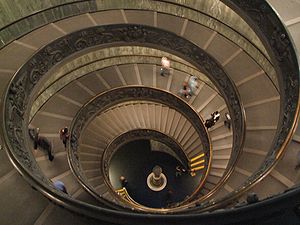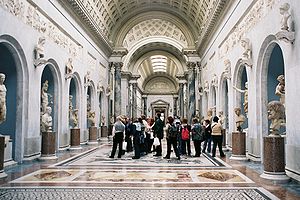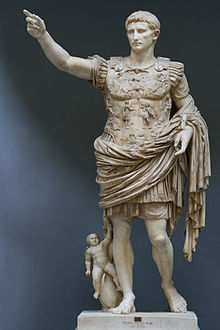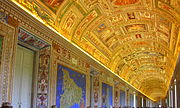- Vatican Museums
-
Vatican Museums Musei Vaticani 
Established 1506 Location Vatican City Visitor figures 4,310,083 (2008)[1] Director Antonio Paolucci Website http://www.museivaticani.va The Vatican Museums (Italian: Musei Vaticani), in Viale Vaticano in Rome, inside the Vatican City, are among the greatest museums in the world, since they display works from the immense collection built up by the Roman Catholic Church throughout the centuries, including some of the most renowned classical sculptures and most important masterpieces of Renaissance art in the world.
Pope Julius II founded the museums in the early 16th century. The Sistine Chapel and the Stanze della Segnatura decorated by Raphael are on the visitor route through the Vatican Museums. They were visited by 4,310,083 people in the year 2007.[1]
Contents
Origins
 Spiral stairs of the Vatican Museums
Spiral stairs of the Vatican Museums
The Vatican Museums trace their origin to one marble sculpture, purchased 500 years ago. The sculpture of Laocoön, the priest who, according to Greek mythology, tried to convince the people of ancient Troy not to accept the Greeks' "gift" of a hollow horse, was discovered 14 January 1506, in a vineyard near the basilica of Santa Maria Maggiore in Rome. Pope Julius II sent Giuliano da Sangallo and Michelangelo Buonarroti, who were working at the Vatican, to examine the discovery. On their recommendation, the pope immediately purchased the sculpture from the vineyard owner. The pope put the sculpture of Laocoön and his sons in the grips of a sea serpent on public display at the Vatican exactly one month after its discovery.
The Museums celebrated their 500th anniversary in October 2006 by permanently opening the excavations of a Vatican Hill necropolis to the public.[2]
Pinacoteca Vaticana
The collection was first housed in the Borgia Apartment, until Pope Pius XI ordered construction of a proper building. The designer was Luca Beltrami. The museum has paintings including:
- Giotto's Stefaneschi Triptych
- Raphael's Madonna of Foligno, Oddi Altarpiece and Transfiguration
- Leonardo da Vinci's St. Jerome in the Wilderness
- Caravaggio's Entombment
- Perugino's Madonna and Child with Saints and San Francesco al Prato Resurrection
- Filippo Lippi's Marsuppini Coronation
Collection of Modern Religious Art
The Collection of Modern Religious Art houses paintings and sculptures from artists like Carlo Carrà and Giorgio de Chirico.
Sculpture museums
The group of museums includes several sculpture museums surrounding the Cortile del Belvedere.
Museo Pio-Clementino
Pope Clement XIV founded the Pio-Clementino Vatican museum in 1771, and originally it contained the Renaissance and antique works. The museum and collection were enlarged by Clement's successor Pius VI. Today, the museum houses works of Greek and Roman sculpture.
There are 54 galleries, or salas, in total, with the Sistine Chapel, notably, being the very last sala within the Museum – visitors need to proceed through the other 53 salas before earning their reward with access to the Sistine. Some notable galleries are:
- Greek Cross Gallery: (Sala a Croce Greca): with the porphyri sarcophagi of Constance and Saint Helen, daughter and mother of Constantine the Great.
- Sala Rotonda: shaped like a miniature Pantheon, the room has impressive ancient mosaics on the floors, and ancient statues lining the perimeter, including a gilded bronze statue of Hercules.
- Gallery of the Statues (Galleria delle Statue): as its name implies, holds various important statues, including Sleeping Ariadne and the bust of Menander. It also contains the Barberini Candelabra.
- Gallery of the Busts (Galleria dei Busti): Many ancient busts are displayed.
- Cabinet of the Masks (Gabinetto delle Maschere): The name comes from the mosaic on the floor of the gallery, found in Villa Adriana, which shows ancient theater masks. Along the walls, several famous statues are shown including the Three Graces.
- Sala delle Muse: Houses the statue group of Apollo and the nine muses as well as statues by important ancient Greek sculptors.
- Sala degli Animali: So named because of the many ancient statues of animals.
Museo Chiaramonti
This museum is named after Pope Pius VII (whose last name was Chiaramonti before his election as pope), who founded it in the early 19th century. The museum consists of a large arched gallery in which sides are exhibited several statues, sarcophaguses and friezes. The New Wing, Braccio Nuovo built by Raphael Stern, houses important statues like The Prima Porta Augustus and The River Nile. Galeria Lapidaria is another part of Chiaramonti museum, with more than 3,000 stone tablets and inscriptions, which is the world's greatest collection of its kind. However, it is opened only by special permission, usually for reasons of study.
Museo Gregoriano Etrusco
Founded by Pope Gregory XIII in 1836, this museum has eight galleries and houses important Etruscan pieces, coming from archaeological excavations. The pieces include: vases, sarcophagus, bronzes and the Guglielmi Collection.
Museo Egiziano
Founded by Pope Gregory XVI, this museum houses a grand collection of Ancient Egyptian material. Such material includes papyruses, the Grassi Collection, animal mummies, and the famous Book of the Dead.
Works in the Vatican museums
- Several paintings by Caravaggio including the majestic Entombment (1602–1603)
- Leonardo da Vinci's portrait of St. Jerome in the Wilderness;
- Works by painters Fra Angelico, Giotto, Raphael, Nicolas Poussin and Titian;
- The red marble papal throne, formerly in the Basilica di San Giovanni in Laterano;
- Roman sculpture, tombstones, and inscriptions, including the Early Christian Sarcophagus of Junius Bassus and Dogmatic sarcophagus, and the epitaph of Lucius Cornelius Scipio Barbatus;
- The Raphael Rooms with many works by Raphael and his workshop, including the masterpiece The School of Athens
- Other Raphael masterpieces including "The Transfiguration".
- The Niccoline Chapel
- The Sistine Chapel
- The Gallery of Maps: topographical maps of the whole of Italy, painted on the walls by friar Ignazio Danti of Perugia, commissioned by Pope Gregory XIII (1572–1585). It remains the world's largest pictorial geographical study.
- The frescoes and other works in the Borgia Apartment built for Pope Alexander VI (Borgia).
On the last Sunday of each month, the Vatican Museum is open to the public for free. This is extremely popular and it is common for people to wait in line for many hours. The other days of the week you can use the online ticket office to purchase an individual ticket or group tour ticket, either of which will enable you to bypass the ticket line completely. This image is a panoramic view of one small stretch of the entire queue in April 2007, which continues for some distance in both directions beyond view.
See also
References
External links
- Vatican Museums official website
- Vatican Museums official on-line ticket office
- Official English information
Coordinates: 41°54′23″N 12°27′16″E / 41.90639°N 12.45444°E
Categories:- Buildings and structures in Vatican City
- Vatican City culture
- Art museums and galleries in Rome
- National museums
- 1506 establishments
- Religious museums
- Museums in Vatican City
- Museums of Ancient Rome
- Museums of Ancient Greece
- Egyptological collections in Italy
- Museums of Dacia
Wikimedia Foundation. 2010.




